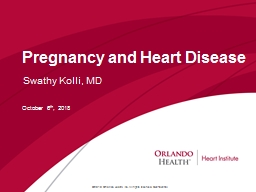

October 6 th 2018 Swathy Kolli MD Epidemiology Epidemiology Spectrum of CVD in pregnancy is changing and differs between countries Risk of CVD in pregnancy has increased due to increasing age at first pregnancy ID: 1012218
Download Presentation The PPT/PDF document "Pregnancy and Heart Disease" is the property of its rightful owner. Permission is granted to download and print the materials on this web site for personal, non-commercial use only, and to display it on your personal computer provided you do not modify the materials and that you retain all copyright notices contained in the materials. By downloading content from our website, you accept the terms of this agreement.
1. Pregnancy and Heart DiseaseOctober 6th, 2018Swathy Kolli, MD
2. Epidemiology
3. EpidemiologySpectrum of CVD in pregnancy is changing and differs between countriesRisk of CVD in pregnancy has increased due to increasing age at first pregnancy Prevalence of cardiovascular risk factors—diabetes, hypertension, and obesity Number of women with congenital heart disease reaching childbearing age Hypertensive disorders are most frequent CV events during pregnancy
4. Physiology
5. Physiological changesPlasma volume 40 % above baseline - 32 weeks30-50% increase in Cardiac outputEarly pregnancy – stroke volumeLate pregnancy – HR increaseSystemic BP drops in early pregnancy (vasodilatation)Heart size can increase by 30%Increase concentration on coagulation factors- ThromboembolismDecreased venous return by enlarging uterus Medication adjustments
6. General considerations
7. Imaging modalities in pregnancyEKG –Transient ST-T wave changes, q wave and inverted T in lead III, inverted T in V1-V3ECHO Holter monitor Exercise testing
8. Radiation doses
9. General recommendations
10. General recommendations
11. High risk pregnancy
12. Q1. Pregnancy is usually discouraged in which of the following conditionsPeripartum cardiomyopathy Vascular Ehler-Danlos syndrome with maximal aortic dimension of 4.0 cmAsymptomatic severe MS Moderate Pulmonary hypertensionAll of the above
13. Pre- pregnancy counsellingHistory and Physical Family historyGenetic counsellingMedicationsEKG, ECHO, Exercise treadmill stress testCT /MRI for aortic pathologyPlan (multidisciplinary)
14. Modified WHO classification of maternal CV risk
15. Modified WHO classification of maternal CV risk
16.
17. Hypertension in pregnancy
18. Q2. Which of the following medications is not preferred in treatment of HTN in pregnancyMethyldopaAtenololHydralazineNifedipine
19. Hypertension in pregnancy – definitionConditionDefinitionPre-existing HTNBP 140/90 precedes pregnancy or develops before 20 weeks gestation (>6 weeks post)Gestational HTNAfter 20 weeks (< 6 weeks)Pre- eclampsia Gestational HTN with significant proteinuria (0.3 g/24 hr)Pre existing HTN + gestational HTN with proteinuria >3 g/24 hour urine after 20 weeksAntenatally unclassifiable HTNNo BP recorded antenatally (reassess at 6 weeks)ConditionDefinitionPre-existing HTNGestational HTNAfter 20 weeks (< 6 weeks)Pre- eclampsia Gestational HTN with significant proteinuria (0.3 g/24 hr)Pre existing HTN + gestational HTN with proteinuria >3 g/24 hour urine after 20 weeksAntenatally unclassifiable HTNNo BP recorded antenatally (reassess at 6 weeks)
20. Risk assessment for pre-eclampsia
21. Prevention and counsellingPre- pregnancy counsellingMay be able to withdraw medications in women with mild to moderate HTNWomen at high or moderate risk – 100-150 mg of ASA (12 weeks -36/37 weeks)Calcium supplementation 1.5-2 gm (if dietary intake <600 mg)
22. USPSTF (US preventive services task force)
23. Non pharmacological measures- Limited roleNormal diet (salt restriction causes low intravascular volume)Weight loss – no data
24. Pharmacological treatment – general principles – Moderate HTNAntihypertensive therapy for mild to moderate hypertension (SBP of 140–169 mmHg and DBP of 90 – 109 mmHg)- controversyESC – >150/95 – Threshold to treatESC - >140/90Gestational HTN, Pre-existing HTN with gestational HTN, sub-clinical end organ damage or symptoms
25. Pharmacological treatment
26. Pharmacological treatment – general principles – severe HTNSevere HTN – ESC > 170/110HospitalizationIV Labetalol, oral Methyldopa or Nifedipine Hydralazine – Not preferred (perinatal effects)Pre-eclampsia with pulmonary edema- NTG gttHTN emergency - Sodium nitroprusside (potential for fetal cyanide toxicity)Induction of delivery - gestational hypertension with proteinuria with adverse conditions such as visual disturbances, coagulation abnormalities, or fetal distress (37 weeks in asymptomatic women)
27. Pharmacological treatment
28.
29. Peripartum cardiomyopathy and CHF
30. DefinitionCardiomyopathy with reduced EF, usually <45%, presenting toward the end of pregnancy or in the months after delivery in a woman without previously known structural heart disease
31. Risk factors RaceAgeMultiple gestationsHypertensive disorders SmokingDM Malnutrition
32. Diagnosis Often delayed High index of suspicion
33. PrognosisImprovement in EF (50-70%)6 monthsSubsequent pregnancy
34. Treatment considerations Volume status Blood pressure MedicationsBromocriptine Fetal considerations (hypoglycemia, bradycardia, respiratory depression)
35. Guideline based medical therapyACE-I / ARB (Benazepril, Captopril, Enalapril)Hydralazine / Nitrates – Metoprolol AtenololDopamine / LevosimendanDiuretics (Furosemide / HCTZ)Aldosterone antagonists – Avoided
36.
37.
38. Hypertrophic cardiomyopathy
39. Venous thromboembolism
40. Venous thromboembolism – Risk factors
41. Risk assessment
42. Venous thromboembolism - Prevention and Treatment
43. Arrhythmias in pregnancy
44. Risk assessment
45. Surveillance level
46. SVT and atrial fibrillation/flutter
47. Ventricular arrhythmias
48. Disorders of Aorta
49. Aortic disease in pregnancy
50. Drugs in pregnancy
51. ClassificationFDA classDefinitionCategory A Safest Category BCan be used with cautionCategory CDrugs should be given only if potential benefits justify the potential risk to the fetus. Category Dbenefits from use in pregnant woman may be acceptable despite the risk (e.g. treatment of life-threatening conditions). Category XThe drug is contraindicated in women who are or may become pregnant.
52.
53. Q3. Anticoagulation in pregnancy Heparin is the preferred drugLMWH is the preferred drugDOAC agents are the preferred drug VKA is the preferred drug Depends on the indication for anticoagulation
54. Anticoagulation in pregnancy - General principlesDiscussion of maternal and fetal risk Mechanical valves – VKA till pregnant, VKA through out if dose is low, UFH or LMWH if VKA dose is high Anti XA levelAtrial fibrillation – Same principles VTE- LMWH (early pregnancy weight) (monitor Anti XA level in high risk)UFH – Around delivery and acute treatment of massive PE
55. High dose VKA
56. Low dose VKA
57. Internet databases www.safefetus.comwww.embryotox.dewww.fda.govwww.ema.Europa.eu
58. References2018 ESC Guidelines for management of CV diseases during pregnancy2011 ESC Guidelines for management of CV diseases during pregnancyUSPSTF recommendations on ASA in pre-eclampsia RCOG – reducing risk of venous thromboembolism during pregnancy and puerperiumACOG – Hypertension in pregnancyFDA.gov
59. Thank you!